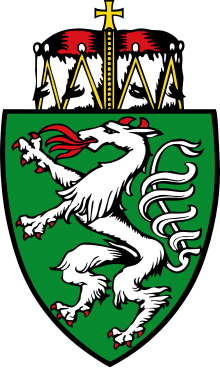History of Styria

The history of Styria concerns the region roughly corresponding to the modern
: Windische Bühel) is a famous wine-producing district, stretching between Slovenia and Austria. Styria was for long the most densely populated and productive mountain region in Europe.Styria's population before
, which is now also the residence of the governor and the seat of the administration of the land.Political history
Prehistory to Charlemagne

The
When Styria came under the hegemony of
Middle Ages
The
With the death of Ottokar the first line of rulers of Styria became extinct; the region fell successively to the
At the time of the Ottoman invasions in the 16th and 17th centuries the land suffered severely and was depopulated. The Turks made incursions into Styria nearly twenty times; churches, monasteries, cities, and villages were destroyed and plundered, while the population was either killed or carried away into slavery.
Modern era

The
Following
Lower Styria was reattached to the Reichsgau Steiermark from 1942 to 1945, whence it was returned to Germany. After World War II, Styria became part of the British occupation zone in Austria. The lower third was granted to Yugoslavia and today, it makes up about the eastern third of Slovenia.
Religious history
The Protestant
After Ferdinand had become Holy Roman Emperor in 1619 and had defeated his Protestant opponents in the Battle of White Mountain near Prague in 1620, he forbade all Protestant church services whatsoever (1625). In 1628 he commanded the nobility also to return to the Catholic faith. A large number of noble families, consequently, emigrated from the country. But most of them either returned, or their descendants did so, becoming Catholics and recovering their possessions.
In the second half of the 17th century renewed action against the Protestants in the isolated mountain valleys resulted in the expulsion of Protestant ministers with the peasants who would not give up Protestantism; about 30,000 chose compulsory emigration to Transylvania over conversion. Only an Edict of Toleration issued by Emperor Joseph II as late as 1781 put an end to religious repression. The Protestants then received the right to found parish communities and to exercise their religion in those enclaves undisturbed.
In 1848, all the provinces of the Habsburg monarchy received complete liberty of religion and of conscience, parity of religions, and the right to the public exercise of religion.
Ecclesiastically the province was historically divided into two Catholic
See also
- Timeline of Graz history
Notes
- ^ "Clickable map of Slovenia"
- ^ Gehrer, Elisabeth (12 May 1998). "The World Heritage Documentation for the Nomination of Semmering Railway – cultural site Semmeringbahn (Kulturlandschaft)" (PDF). UNESCO World Heritage Centre. p. 13. Archived (PDF) from the original on 10 October 2015. Retrieved 11 June 2021.
- ^ Gehrer, Elisabeth (12 May 1998). "The World Heritage Documentation for the Nomination of Semmering Railway – cultural site Semmeringbahn (Kulturlandschaft)" (PDF). UNESCO World Heritage Centre. pp. 4–5. Archived (PDF) from the original on 10 October 2015. Retrieved 11 June 2021.
- ^ History of Graz-Seckau diocese. Retrieved 31 July 2010.
